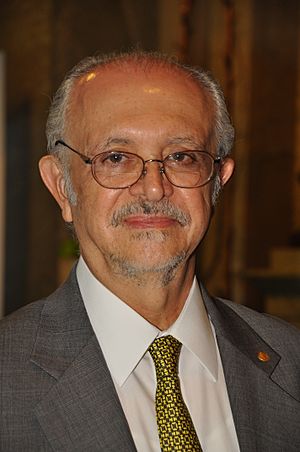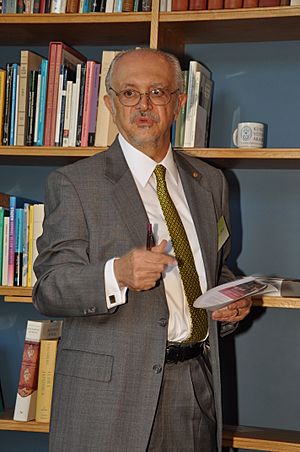Mario J. Molina facts for kids
Quick facts for kids
Mario J. Molina
|
|
|---|---|

Molina in 2011
|
|
| Born |
Mario José Molina Henríquez
March 19, 1943 Mexico City, Mexico
|
| Died | October 7, 2020 (aged 77) Mexico City, Mexico
|
| Education |
|
| Spouse(s) |
|
| Awards |
|
| Scientific career | |
| Fields | Chemistry |
| Institutions | |
| Thesis | Vibrational Populations Through Chemical Laser Studies: Theoretical and Experimental Extensions of the Equal-gain Technique (1972) |
| Doctoral advisor | George C. Pimentel |
| Doctoral students | Renyi Zhang |
Mario José Molina Henríquez (March 19, 1943 – October 7, 2020), was a Mexican chemist. He played an important role in the discovery of the Antarctic ozone hole and was a co-recipient of the 1995 Nobel Prize in Chemistry for his role in discovering the potential threat to the Earth's ozone layer from chlorofluorocarbon (CFC) gases. He was the first Mexican-born scientist to receive a Nobel Prize in Chemistry and the third Mexican-born person to receive a Nobel prize.
Contents
Early life and education
Molina was born in Mexico City to Roberto Molina Pasquel and Leonor Henríquez. His father was a lawyer and diplomat who served as an ambassador to Ethiopia, Australia, and the Philippines. His mother was a family manager.
Mario Molina attended both elementary and primary school in Mexico. When he was 11, his parents sent him to a boarding school in Switzerland at Institut auf dem Rosenberg, where he learned to speak German. At first, Mario was disappointed because most of his classmates did not have the same interest in science as he did.
Molina went on to earn his bachelor’s degree in chemical engineering at the National Autonomous University of Mexico (UNAM) in 1965. Following this, Molina studied polymerization kinetics at the Albert Ludwig University of Freiburg, West Germany for two years. Next, he was accepted for graduate study at the University of California, Berkeley in 1968 and earned his Ph.D. in physical chemistry in 1973.
Career
After completing his Ph.D., he enrolled in a research program at UC Berkeley, with Sherwood Rowland. The two men studied Chlorofluorocarbons (CFCs) and would later on make one of the largest discoveries in atmospheric chemistry.
Work on CFCs
Rowland and Molina studied CFCs, apparently harmless gases that were used in refrigerants, aerosol sprays, and the making of plastic foams. They asked the question, "What is the consequence of society releasing something to the environment that wasn’t there before?" From there, they developed their CFC ozone depletion theory. First, Molina tried to figure out how CFCs could be decomposed. Molina theorized that photons from ultraviolet light, known to break down oxygen molecules, could also break down CFCs. This would release several products including chlorine atoms into the stratosphere. Molina and Rowland predicted that chlorine atoms, produced by this decomposition of CFCs, would act as an ongoing catalyst for the destruction of ozone. Their theory of ozone depletion would influence the public to reduce their use of CFCs. In 1985, after Joseph Farman discovered a hole in the ozone layer in Antarctica, Mario Molina led a research team to further investigate the cause of rapid ozone depletion in Antarctica. It was found that the stratospheric conditions in Antarctica were ideal for chlorine activation, which ultimately causes ozone depletion. Molina later shared the Nobel Prize in Chemistry in 1995 with Paul J. Crutzen and F. Sherwood Rowland because of their work on CFCs.
Between 1974 and 2004, Molina held research and teaching posts at University of California, Irvine; the Jet Propulsion Laboratory at Caltech; and the Massachusetts Institute of Technology (MIT). On July 1, 2004, Molina joined the Department of Chemistry and Biochemistry at University of California, San Diego, and the Center for Atmospheric Sciences at the Scripps Institution of Oceanography.
He also served on the board of directors of various scientific foundations and companies including the John D. and Catherine T. MacArthur Foundation and Xyleco.
Molina was named by U.S. President Barack Obama to form a transition team on environmental issues in 2008. Under President Obama, he was a member of the United States President's Council of Advisors on Science and Technology.
In 2020, Mario Molina was part of a team of scientists who said it was important for people to wear masks during the COVID-19 pandemic.
Personal life and death
Molina married fellow chemist Luisa Y. Tan in July 1973. They met when Molina was pursuing his Ph.D. at the University of California, Berkeley. They moved to Irvine, California in the fall of that year. Their son, Felipe Jose Molina, was born in 1977. The couple divorced in 2005. Luisa Tan Molina is now the lead scientist of the Molina Center for Strategic Studies in Energy and the Environment in La Jolla, California. Molina married his second wife, Guadalupe Álvarez, in February 2006.
Molina died on October 7, 2020, at age 77, due to a heart attack.
Awards
- 1987: Molina won the Esselen Award of the Northeast section of the American Chemical Society.
- 1988: He won the Newcomb Cleveland Prize from the American Association for the Advancement of Science.
- 1989: the 1989 NASA Medal for Exceptional Scientific Advancement and the United Nations Environmental Programm Global 500 Award.
- 1990: The Pew Charitable Trusts Scholars Program in Conservation and the Environment honored him as one of ten environmental scientists and awarded him a $150,000 grant.
- 1995: Molina shared the 1995 Nobel Prize in chemistry with Paul J. Crutzen and F. Sherwood Rowland for their discovery of the role of CFCs in ozone depletion.
- 1996: Molina received the Golden Plate Award of the American Academy of Achievement.
- 1993: Molina was elected to the United States National Academy of Sciences.
- 1996: He was elected to the United States Institute of Medicine.
- 1998: He received the Willard Gibbs Award from the Chicago Section of the American Chemical Society and the American Chemical Society Prize for Creative Advances in Environment Technology and Science.
- 2003: He became a mameber of The National College of Mexico. Molina also received the 9th Annual Heinz Award in the Environment.
- 2007: He was elected to the American Philosophical Society and was a member of the Mexican Academy of Sciences.
- 2013: U.S. President Barack Obama announced Molina as a recipient of the Presidential Medal of Freedom.
- 2014: Molina was a fellow of the American Association for the Advancement of Science and co-chaired the 2014 AAAS Climate Science Panel, What We Know: The reality, risks and response to climate change. He also received the Lifetime Achievement Award (Champions of the Earth).
Honorary degrees
Molina received more than thirty honorary degrees.
- Yale University (1997)
- Tufts University (2003)
- Duke University (2009)
- Harvard University (2012)
- Mexican Federal Universities: National of Mexico (1996), Metropolitana (2004), Chapingo (2007), National Polytechnic (2009)
- Mexican State Universities: Hidalgo (2002), State of Mexico (2006), Michoacan (2009), Guadalajara (2010), San Luis Potosí (2011)
- U.S. Universities: Miami (2001), Florida International (2002), Southern Florida (2005), Claremont Graduate (announced 2013)
- U.S. Colleges: Connecticut (1998), Trinity (2001), Washington (2011), Whittier (2012), Williams (2015)
- Canadian Universities: Calgary (1997), Waterloo (2002), British Columbia (2011)
- European Universities: East Anglia (1996), Alfonso X (2009), Complutense of Madrid (2012), Free of Brussels (2010),
Works
- Molina, Luisa T., Molina, Mario J. and Renyi Zhang. "Laboratory Investigation of Organic Aerosol Formation from Aromatic Hydrocarbons," Massachusetts Institute of Technology (MIT), United States Department of Energy, (August 2006).
- Molina, Luisa T., Molina, Mario J., et al. "Characterization of Fine Particulate Matter (PM) and Secondary PM Precursor Gases in the Mexico City Metropolitan Area," Massachusetts Institute of Technology (MIT), United States Department of Energy, (October 2008).
Mario Molina quotes
- “Finding out for myself, for the first time, how something works is really an enormous driving force.”
- “Many Latino kids should become scientists because we need scientists all over the world from all different backgrounds.”
- “Climate change, like depletion of the ozone layer, is proof of the damage human activities exert on earth at the global level.”
Interesting facts about Mario Molina
- Mario Molina had developed a deep interest in chemistry before attending high school.
- When he was a child, he converted a bathroom in his home into his own little laboratory, using toy microscopes and chemistry sets.
- Ester Molina, Mario’s aunt, and an already established chemist, nurtured his interests and aided him in completing more complex chemistry experiments.
- Mario had initially wanted to become a professional violinist, but his love for chemistry triumphed over that interest.
- In his career, Molina held research and teaching positions at University of California, Irvine, California Institute of Technology, Massachusetts Institute of Technology, University of California, San Diego, and the Center for Atmospheric Sciences at the Scripps Institution of Oceanography.
- Molina established the Mario Molina Center for Energy and Environment in Mexico City in 2005 and served as its director.
- Molina was a climate policy advisor to the President of Mexico, Enrique Peña Nieto.
- Molina served on the board of trustees for Science Service, now known as Society for Science & the Public, from 2000 to 2005.
- Molina was one of twenty-two Nobel Laureates who signed the third Humanist Manifesto in 2003.
- Asteroid 9680 Molina is named in his honor.
- On March 19, 2023, Molina was the subject of a Google Doodle in Mexico, the United States, Brazil, India, Germany, France, and other countries.
See also
 In Spanish: Mario Molina (químico) para niños
In Spanish: Mario Molina (químico) para niños



